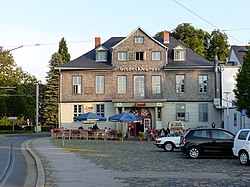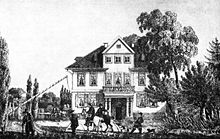Great way home
| Great way home | |
|---|---|
 View of the Großer Weghaus from the north after the renovation in 2014 |
|
| Data | |
| place | Braunschweig-Stöckheim |
| Client | Johann Urban Müller |
| Architectural style | Baroque |
| Construction year | 1691/1693 |
| Coordinates | 52 ° 12 '32.7 " N , 10 ° 31' 26.9" E |
 Historical site plan with the manorial path between Wolfenbüttel and Braunschweig |
|
The Große Weghaus in Stöckheim is a former customs house from 1691, which is now also used as a restaurant. It stands in the central axis of Leipziger Strasse, which was led around the building.
history
The building was built at the end of the 17th century as a customs and guest house. This was preceded by the conquest of the city of Braunschweig by Duke Rudolf August von Braunschweig-Wolfenbüttel in 1671. He then moved his residence from Wolfenbüttel to Braunschweig to the Grauen Hof , the location of the later Braunschweig Palace . In this context, a so-called Herrschaftlicher Weg was laid out around 1680 parallel to the old trade route ( Alter Weg ), which, coming from Wolfenbüttel, ended at Stöckheim in the Leipziger Heerstrasse that existed at the time and is also known as the Baroque route .
For 1691 it is recorded that the chamber secretary Johann Urban Müller received the right to build an inn there in a letter of freedom and inheritance from the dukes Rudolf August and Anton Ulrich . The special thing about the building is that it was a kind of drive-in : the ducal family could drive into the dining room with the carriage. To protect the doors from the steel wheel tires, old cannon barrels were dug in as bollards.
A baroque garden was laid out adjacent to the building, of which only remains and the name Weghausgarten are available today.
In 1724 the Brunswick dukes acquired the building and leased it to various innkeepers. From 1753, was for the use of manorial way one-way tariff levied. At that time the path already led around the building and was blocked off by a barrier.
At the beginning of the 19th century, a newly established stagecoach line and later the railway led to a decline in customs revenue. In 1868 the road toll was completely lifted, since then everyone has been able to freely use the comfortable route between Stöckheim and Wolfenbüttel. The inn was sold to private operators and is still privately owned today.
The house was and is a popular place for excursions for decades and at times served as a post office and school. Today the connecting road to Wolfenbüttel ( Leipziger Strasse ) runs along the route of the Herrschaftliche Weg , which forms a section of federal road 79 south of the Braunschweig urban area as Neuer Weg . From 1897 to 1954 line A of the Braunschweig tram ran past the Großer Weghaus to Wolfenbüttel.
Historical meaning
Due to its location between Braunschweig and Wolfenbüttel and its charming surroundings near the Oker , the Große Weghaus has been a meeting place for day-trippers, including famous people, for centuries.
Gotthold Ephraim Lessing met here regularly with scholars from the Collegium Carolinum , the forerunner of today's Technical University of Braunschweig . This included Johann Joachim Eschenburg , among others .
The Braunschweiger clothes sellers with Wilhelm Raabe were about the closest known guests who would come centuries later also walking distance from the city to this home. Between 1850 and 1860 Wilhelm Raabe described the Weghaus in Wunnigel , where it bears the name Riedhorn .
Today's meaning
It is still used as a restaurant today. Since 2006 a tram line has been running in Hauptstrasse again.
The house was extensively renovated in 2013. The windows correspond to the original style, the roof clearly stands out from the neighboring buildings. The originally small dormers have been replaced by larger ones to improve living conditions.
Little way house
A "small road house" in the Feldmark in the direction of Mascherode has been handed down, but no longer exists. According to the information in the Braunschweig General Land Survey , which took place from 1748 to 1784, it was on the manorial road from Braunschweig to Salzdahlum on the border between Melverode and Mascherode on the border ditch of the former Landwehr . This route ran from Braunschweig along today's Salzdahlumer Straße to Heidberg and from there pretty much along today's west side of the Heidbergsee on the route of the current high-voltage line. The location of the Kleiner Weghaus was on the southwest corner of the lake on the Graben ( 52 ° 13 ′ 20.1 ″ N , 10 ° 32 ′ 40.4 ″ E ) and marked the course of the Landwehr to the west.
literature
- Wilhelm Bornstedt : Chronicle of Stöckheim , Braunschweig 1967.
- Mathias Haenchen: 300 years of Weghaus in Stöckheim , Braunschweig 1992.
- Rudolf Zehfuß: Great way house . In: Braunschweiger Stadtlexikon , Braunschweig 1992, p. 93.
Web links
Individual evidence
- ↑ Dieter Grothenn: August Papen and his "Topographical Atlas of the Kingdom of Hanover and Duchy of Braunschweig" . In: News of the Lower Saxony Surveying and Cadastre Administration . 46th year, No. 4, Hannover 1996, p. 158.


